Geography of dog agility
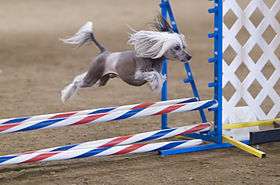
Dog agility is now an international dog sport with many different sanctioning organizations and competitions worldwide.
Agility in the United Kingdom
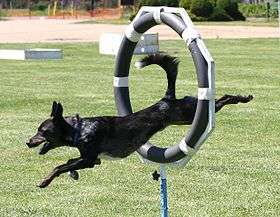
Eligibility for competition
Dogs of all sizes and origins are eligible to compete at agility shows in the UK, provided that they are:
- Registered with the show's organising body, where required
- A minimum of 18 months of age (16 months in UKA nursery classes)
- Not a bitch in season
- Not suffering from any infectious or contagious disease
- Not of such a temperament as to be a danger to the safety of any person or other animal
- Not in a physical condition that would cause suffering when competing
Kennel Club shows
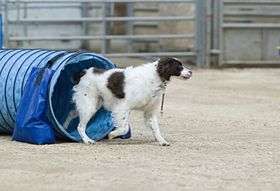
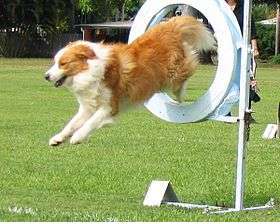
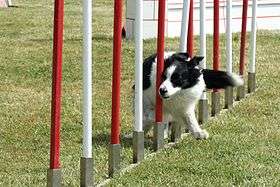
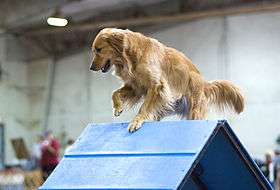
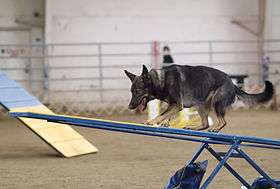
Agility shows run by clubs that are affiliated to the Kennel Club continue to dominate the British agility scene. They host qualifiers for the most prestigious competitions at Crufts dog show near Birmingham each March, and Olympia in London each December. They also provide a route for winning the three Championship classes needed to gain an agility dog the coveted 'Agility Champion' title.
Progression at KC shows is via a win-based system or a dog can progress on points if the handler chooses. Classes can number anything up to 450 dogs and class sizes vary considerably. They can be as small as 4 or 5 dogs or as large as 200 dogs. If a larger number of entries is received for one class then the organising club will generally split the class into separate parts with a separate set of prizes for each part. Generally classes for small and medium-sized dogs are smaller than for the large dogs. From January 2007, the KC has adopted a new grading system. Dogs with new handlers start in Grade 1 Elementary, and if they gain the wins required move up through Starters, Graduate, Novice, Intermediate and Senior to Grade 7 Advanced level. By the time a dog reaches Advanced (at which point it becomes eligible for Championship classes), it will have won many classes. The new grading system also provides the option to progress as far as Grade 5 Intermediate via a points system, run in conjunction with the Kennel Club's Agility Warrant (AW) agility titles.
The Kennel Club introduced its International Festival of Agility in 2005, a weekend event that hosts a range of national team and individual competitions and finals, including the British Open. The KC also funds the British agility team that is sent to the FCI world championships each year.
Other UK agility shows
The British Agility Association (BAA) was launched in 2006 Following the success of EMDAC (East Midlands Dog Agility Club which was the first Independent Agility Association in the UK founded in 2002 by June Bass & Steve Retter) BAA provides its own progression system, with dogs being promoted via a ranking system based on performance at BAA shows. BAA shows are run both by the main EMDAC team and BAA affiliated independent clubs around the country. EMDAC host the BAA National Finals, a 3-day event in August each year.
UK Agility (UKA), launched in 2004, provides two separate progression programmes leading to agility titles. The Performance programme requires points to be gained in a range of Agility, Jumping and Games classes such as Gamblers and Snooker. This titling system has many similarities with that of the USDAA in the United States. The Steeplechase programme is based on Steeplechase classes consisting only of jumps and tunnels. UKA shows are run by both the main UKA team and affiliated independent clubs. UKA runs a weeklong show with its national championships in August each year, and also sends a team to the IFCS world championships.
In addition, a number of independent clubs and groups around the United Kingdom hold one-off shows or short series of shows that are not affiliated with any of the above organisations.
Agility in Canada
In Canada dog agility is largely sanctioned by the Agility Association of Canada (AAC). In western Canada however, it is not uncommon to also see trials sanctioned by the North American Dog Agility Council (NADAC); in eastern Canada NADAC sanctioned trials are rare. Canadian Kennel Club (CKC) agility trials are uncommon and are mostly associated with specialty shows for purebreds in conjunction with other events.
Agility in the United States
The first agility competition in the United States took place around 1986 under the rules of the newly formed United States Dog Agility Association (USDAA).
Qualification for competition
For all organizations, dogs can compete provided that they are:
- Registered with the specific organization
- Physically sound (blindness, deafness AKC Regulations, and physical impairments interfering with functional movement may disqualify a dog from eligibility; consult each organization for more specific information)
- At least the minimum age (for example, 15 months in AKC and CPE, 18 months in USDAA and NADAC)
- Not a female in heat
- Well-behaved enough to be off leash around other dogs and people; for example, dogs who attack the judge, other people, or other dogs may be expelled from the trial site and may eventually be banned from competing
Dogs of any size, ancestry, or nationality can compete, except for in TDAA, which limits dogs to those of no more than 17" at the withers. On April 1, 2010, the AKC began allowing mixed breed dogs to compete in agility along with purebred dogs and dogs with a PAL/ILP listing.
Agility titles and championships
For most sanctioning organizations, there are a variety of titles that a dog and handler can earn by accruing sufficient qualifying runs—also called legs—that is, runs that have no more than a certain number of faults (typically none) and are faster than the maximum standard course time (SCT).
For example, under USDAA rules, a dog can earn novice-level titles in Standard, Jumpers, Gamblers, Snooker, and Pairs Relay classes by earning 3 qualifying runs in each of the classes; the dog can also earn intermediate-level titles and masters-level titles in the same classes. After earning all of the masters-level titles—five qualifying runs in each, with some that must be in the top 15% of dogs competing at each trial—the dog earns its Championship. Other organizations have similar schemes; in AKC, to earn the Championship, the dog's qualifying runs must be earned two at a time on the same day; in NADAC, the quantity of qualifying runs is much larger; and so on. Most champion titles have "CH" in the title: NATCH (NADAC Agility Trial Champion), ADCH (Agility Dog Champion for USDAA), CATCH (CPE Agility Trial Champion), MACH (Master Agility Champion for AKC), TACH (Teacup Agility Champion), ATCH (ASCA Agility Trial Champion) and so on.
National championships
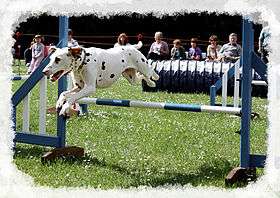
In addition, each sanctioning organization holds its national championships each year. Dogs must meet certain minimum scoring requirements to qualify to compete in the annual championship; for example, the dog must earn qualifying scores in at least 50% of the runs at each of at least 3 trials during the year; or must place in the top certain percentage of dogs at certain trials; or must have a qualifying run in special regional qualifying events; and so on.
As with any agility competition, there are national champions in each height category because it is not possible for dogs of greatly different sizes to compete equally.
USDAA national championships
USDAA has 12", 16", 22", and 26" (30, 40, 55, and 66 cm) jump-height categories; it crowns four national Grand Prix champions each year, as well as four Veterans and four Performance (lower-level performance) Grand Prix champions. It also holds championships for its Dog Agility Steeplechase and its Dog Agility Masters Three-Dog Team tournament series.
AKC national championships
To qualify for the AKC Dog Agility Nationals, dogs must obtain double Qs and points during the preceding year. (The exact number of each has been increasing each year - for 2008 it is 6 double Qs and 400 MACH points.) A double Q means that the dog has earned qualifying scores in both runs of a single day of competition. Points are earned by the number of seconds under the standard course time that the dog takes to run a course, and are multiplied by various factors based on placement. At Nationals, dogs compete against their height division of 8", 12", 16", 20", 24", or 26". The AKC Nationals are often televised.
The AKC also runs an annual breed invitational to represent the best dogs from each breed. The invitational qualification and competition are similar to those of the Nationals.
List of organizations that will sanction agility
North America
Agility only
- Agility Association of Canada (AAC). External link:
- Canine Performance Events (CPE). External link:
- Dogs On Course North America (DOCNA). External link:
- North American Dog Agility Council (NADAC). External link:
- Teacup Dogs Agility Association (TDAA). External link:
- United States Dog Agility Association (USDAA). External link:
Other activities in addition to agility
- American Kennel Club (AKC). External link:
- Australian Shepherd Club of America (ASCA). External link:
- Canadian Kennel Club (CKC). External link:
- United Kennel Club (UKC). Started as NCDA, which in 1995 became the UKC agility program. External link:
Oceania
- Agility Dog Association of Australia (ADAA). External link:
- Australian National Kennel Council (ANKC). External link:
- International Agility Link (IAL). External link:
- NADAC - Australian Division (NADAC). External link:
- National Agility Link Association (NALA). External link:
- New Zealand Kennel Club (NZKC). External link:
Europe
- British Agility Association. External link:
- The Kennel Club (KC). External link:
- Slovak Agility Clubs Association. External link:
- UK Agility. External link:
Asia
- Penang Dog Agility Association (PAAPP). External link:
- Philippine Dog Athletics Association (PDAA). External link:
International championships
Some competitions invite qualified entrants from multiple countries, thereby making them international championships. Examples include:
- Fédération Cynologique Internationale Agility World Championships, the oldest and best-known, is held every year. It had been held in Europe every year until 2013, where it is to be hosted by South Africa. The event was held as a European championship until 1995, then a world championship from 1996, and is restricted to registered pedigree dogs only. The FCI has more than 80 member countries (via each country's kennel club), over 30 of which typically take part in the FCI World Championships. The British, American and Canadian kennel clubs are not FCI members, but their teams are allowed to participate by special invitation.
- The International Mix & Breed Championship in Agility (IMCA), first held in Italy in 2000 as a response to the FCI pedigree-only championships. The competition is held annually with about 18 countries participating, including teams from outside Europe. Now open to any breed or mixed-breed dog regardless of origins, and in Europe considered to be the main international rival to the FCI championships.
Since the 2002 IMCA (Gyula, Hungary), this championship is organised together with the ParAgility World Cup for disabled competitors.
- The International Federation of Cynological Sports (IFCS), has since 2002 organized a biannual world agility championship open to any breed or mixed-breed dog regardless of pedigree. English-speaking member or associate member countries include the United States (via the United States Dog Agility Association), the United Kingdom (via UK Agility), Canada (via the Agility Association of Canada), and Australia (via the Agility Dog Association of Australia). Ten countries participated in the event in 2006.
- The Cynosport World Games, officially named in 2003, as the consolidated venue for USDAA's three tournament series - Grand Prix of Dog Agility, $10,000 Dog Agility Steeplechase and Dog Agility Masters Three-Dog Team Championship — and exhibitions and competitions in other popular canine sports. USDAA tournaments were opened to invited overseas participants for the first time in 2001, which led to establishment of USDAA affiliates in other countries where qualifying events are now held each year. Prior to 2001, USDAA qualifying events were limited to Canada, Mexico, Puerto Rico and the United States. The Cynosport World Games in 2006 attracted some 1,000 competitors in dog agility from twelve countries, and also now includes world championship events in flyball and flying disc. Participants from other countries may still apply for participation by invitation if USDAA qualifying events are not held in their country or region.
- The European Open. An informal annual championships since its foundation in 2002, open to all dogs regardless of origins. It rotates around a small number of countries in central Europe, though attracting competitors from all over Europe, with 25 countries due to participate in the 2006 event. From 2007, the competition will be held under Fédération Cynologique Internationale regulations, with a view to developing it into a 'World Open'. In years when the World Dog Show is held in Europe, the European Open will be held at the World Show and not separately.